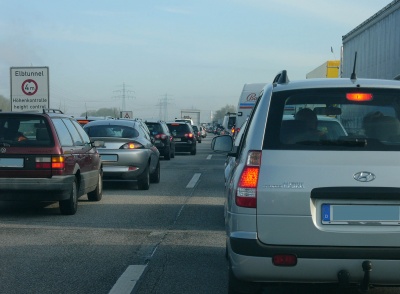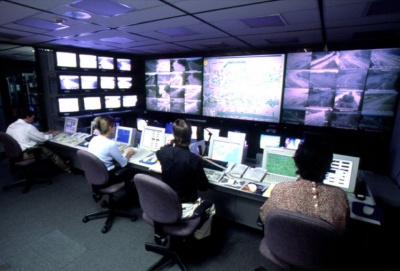If you wish to contribute or participate in the discussions about articles you are invited to contact the Editor
Traffic Management: Difference between revisions
Rui.Pereira (talk | contribs) mNo edit summary |
Carlos.Lopez (talk | contribs) No edit summary |
||
| Line 1: | Line 1: | ||
{{Article Infobox2 | {{Article Infobox2 | ||
|Category=Applications | |Category=Applications | ||
| | |Editors=GMV | ||
|Level=Basic | |Level=Basic | ||
|YearOfPublication=2011 | |YearOfPublication=2011 | ||
|Title={{PAGENAME}} | |Title={{PAGENAME}} | ||
}} | }} | ||
Revision as of 10:58, 23 February 2012
| Applications | |
|---|---|
| Title | Traffic Management |
| Edited by | GMV |
| Level | Basic |
| Year of Publication | 2011 |
Congestion of public road networks is a growing problem in many countries. Authorities are developing initiatives to manage the traffic, but no remedial strategy can be better than the information upon which it has to rely. Consequently, the traffic planners need information that is accurate, reliable, timely and complete. The road users too need good-quality traffic information in order to plan and adjust their routes[1].
The monitoring and management of traffic fluidity will be significantly facilitated when a great number of cars are equipped with satellite navigation receivers and guidance systems. For example, if the average speed of the cars equipped with GNSS receivers in a road sector drops significantly, a control center can anticipate a traffic jam and suggest that approaching vehicles choose different routes. Several studies have concluded that travel time would be cut by 10-20%[2].
Application Characterization
The use of GNSS for traffic management has been envisioned by authorities all over the world. With the growth of traffic, more traffic information is required to regulate traffic flow and guarantee traffic safety. With additional traffic information the road infrastructure can be optimized by guiding the traffic and controlling the traffic flows. Such systems would be able to provide route guidance, in case of traffic jams, incidents or road works.
Traffic information has traditionally been collected with inductive-loop detectors embedded in the roads and with video cameras. These fixed installations do not give any traffic information beyond the locations where they are installed, and their coverage is usually confined to congestion-sensitive motorways and a limited number of tunnels, bridges and intersections[1].
Using GNSS technologies for the gathering of ‘floating-car’ data is a totally different concept, whereby a relatively small percentage of the vehicle population generates real-time traffic information just by participating in the traffic flow. The data being collected by the participating vehicles is immediately communicated to a central facility for processing. This approach allows the collection of traffic data across the whole road network – including towns, cities, rural roads and currently unmonitored motorway segments. Floating-car data also has the potential to provide better-quality information. The tracer vehicles can log travel times over a series of road segments, whereas traditional systems measure the traffic only at specific points. In addition, tracer vehicles can detect and report various types of traffic ‘events’ as they occur[1].
Application Architecture
This application relies on the installation on vehicle of a vehicle tracker or a similar GNSS device that can collect the vehicle position and send it over a communication link to a central server. These devices can be specific for traffic management or can take advantage and be integrated with of other GNSS systems on the vehicle such as navigation systems, fleet management systems, tolling systems or incident management systems.
In these systems the position of the vehicle is mapped into the corresponding road using map-matching techniques. If the accuracy is enough, lane matching can be also done. In simple terms when vehicle velocity drops below a certain value this is signaled as a possible traffic congestion and the data from other vehicles in the same road is analyzed to determine the traffic flow speeds in that road.
As tolling systems these systems can present different levels of centralization:
- Centralized: In this architecture the on-board device is a very light footprint and cost-effective device, with a reduced processing power and just calculates the PVT (Position, Velocity and Time), to combine it with the identification of the vehicle and to transmit the data to the traffic control center.
- Decentralised: The map-matching is done in the on-board device and only if the velocity of the vehicle is outside specific thresholds for each road the PVT is sent to the traffic control center. This approach might support also the request on-demand of the PVT by the traffic control center.
The positions and velocities of the vehicles are sent over the communication link (usually the cellular network) to a traffic control center. The information obtained from the tracer vehicle can be combined with other sources such as traditional road loops, the traffic flow of mobile phone users on the road and historical traffic data. With this information the traffic flow for a road or a section of a road can be determined and even predicted for the future[3].
With the realtime information of the traffic flows over the road network the traffic control center can use road side equipment or traffic information systems to minimize congestion situation. This can be done by recommending alternative route in the variable message display in the road, to regulate traffic flow using semaphores, to open or close temporary or bidirectional lanes and by providing this information to traffic information systems.
Traffic management systems can be integrated with traffic information systems that can suggest alternative route to the drivers. If the on-board device that collects the PVTs of the vehicle has a human-machine interface (display and/or audio interface) the same device can be used to provide traffic information and even navigation proving an alternative route to the driver.
Application Examples
The main problem to this approach is the requirement to have a minimum set vehicles in order for the data to be meaningful and representative. In the trials that were done is different places normally utility fleets such as taxis, public transport and other are used as tracer vehicles. This approach has been enough to prove the system functionality but for a operational system a wider vehicle population is required. Some operational systems have addressed this issue by using the traffic flow of mobile users obtained from cellular telecommunications operators. One approach to achieve this wider vehicle population is to have this application integrated with other applications that either are required (e.g. tolling) or that can provide other valuable services to the driver (e.g. navigation, emergency services, traffic information).
Trials
Trials on the use of GNSS for traffic management have been promoted in several cities by local authorities. Examples of such trials are:
- RTMS trial in Rotterdam and Den Haag
- ARMAS Phase III Traffic Management Trials in The Netherlands
Operational Traffic Information Systems
Currently there are some operational traffic information system operated by private companies on the road navigation and road mapping area. These services don't provide actual traffic management but only a traffic information service. When subscribing to these systems, the users benefit from the suggestion of alternative route by their navigation system. The information produced by these systems and the technologies used are the same that a GNSS based traffic management system would use. Examples of such systems are:
- Tom Tom HD Traffic
- Navteq Traffic
Notes
References
- ^ a b c Road Traffic Monitoring by Satellite, ESA bulletin 115, August 2003
- ^ Galileo Application Sheet - Road Applications, ESA and European Commission, October 2002
- ^ How TomTom’s HD Traffic™ and IQ Routes™ data provides the very best routing Tom Tom White Paper


